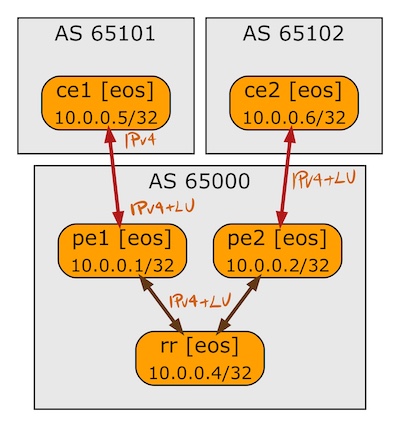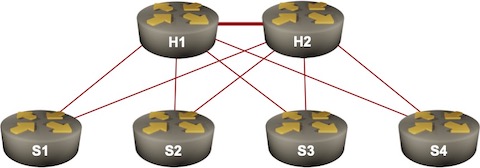Category: MPLS
BGP Labeled Unicast on Arista EOS
A week ago I described how Cisco IOS implemented BGP Labeled Unicast. In this blog post we’ll focus on Arista EOS using the same lab as before:

BGP sessions in the BGP-LU lab
BGP Labeled Unicast on Cisco IOS
While researching the BGP RFCs for the Three Dimensions of BGP Address Family Nerd Knobs, I figured out that the BGP Labeled Unicast (BGP-LU, advertising MPLS labels together with BGP prefixes) uses a different address family. So far so good.
Now for the intricate bit: a BGP router might negotiate IPv4 and IPv4-LU address families with a neighbor. Does that mean that it’s advertising every IPv4 prefix twice, once without a label, and once with a label? Should that be the case, how are those prefixes originated and how are they stored in the BGP table?
As always, the correct answer is “it depends”, this time on the network operating system implementation. This blog post describes Cisco IOS behavior, a follow-up one will focus on Arista EOS.
MPLS/LDP Creation Myths
Hannes Gredler wrote an interesting comment to my Segment Routing vs LDP in Hub-and-Spoke Networks blog post:
In 2014 when I did the first prototype implementation of MPLS-SR node labels, I was stunned that just with an incremental add of 500 lines of code to the vanilla IPv4/IPv6 IS-IS codebase I got full any-to-any connectivity, no sync issues, no targeted sessions for R-LFA …. essentially labeled transport comes for free.
Based on that, one has to wonder “why did we take the LDP detour and all the complexity it brings?”. Here’s what Hannes found out:
… updated on Friday, March 18, 2022 07:02 UTC
Hub-and-Spoke VPLS: Revenge of LDP
In the Segment Routing vs LDP in Hub-and-Spoke Networks blog post I explained why you could get into interesting scaling issues when running MPLS with LDP in a large hub-and-spoke network, and how you can use Segment Routing (MPLS edition) to simplify your design.

Sample hub-and-spoke network
Now imagine you’d like to offer VPLS services between hubs and spokes, and happen to be using equipment that uses targeted LDP sessions to signal pseudowires. Guess what happens next…
Segment Routing vs LDP in Hub-and-Spoke Networks
I got an interesting question that nicely illustrates why Segment Routing (the MPLS variant) is so much better than LDP. Imagine a redundant hub-and-spoke network with hundreds of spokes. Let’s settle on 500 spokes – IS-IS supposedly has no problem dealing with a link-state topology of that size.

Let’s further assume that all routers advertise only their loopbacks1 and that we’re using unnumbered hub-to-spoke links to minimize the routing table size. The global routing table thus contains ~500 entries. MPLS forwarding tables (LFIB) contain approximately as many entries as each router assigns a label to every prefix in the routing table2. What about the LDP table (LIB – Label Information Base)?
… updated on Monday, January 31, 2022 19:26 UTC
Sample Lab: SR-MPLS on Junos and SR Linux
Last week I published a link to Pete Crocker’s RSVP-TE lab, but there’s more: he created another lab using the same topology that uses SR-MPLS with IS-IS to get the job done.
Jeroen Van Bemmel did something similar for SR Linux: his lab topology has fewer devices (plus SR Linux runs in containers), so it’s easily deployable on machines without humongous amount of memory.
… updated on Wednesday, February 16, 2022 16:15 UTC
Anycast Works Just Fine with MPLS/LDP
I stumbled upon an article praising the beauties of SR-MPLS that claimed:
Yet MPLS, until recently, was deprived of anycast routing. This is because MPLS is not a pure packet switching technology, but has a control plane based on virtual circuit switching.
My first reaction was “that’s not how MPLS works,”1 followed by “that would be fun to test” a few seconds later.
BGP-Free MPLS Core with Segment Routing
After I created the Segment Routing lab to test the relationship between Node Segment ID (SID) and MPLS labels, I was just a minor step away from testing BGP-free core with SR-MPLS.
I added two nodes to my lab setup, this time using IOSv as those nodes need nothing more than EBGP support (and IOSv is tiny compared to IOS XE on CSR):
Segment Routing Segment IDs and MPLS Labels
In one of my introductory Segment Routing videos, I made claims along the lines of “Segment Routing totally simplifies the MPLS control plane, replacing LDP and local labels allocated to various prefixes with globally managed labels advertised in IGP”
It took two years for someone to realize the stupidity over-simplification of what I described. Matjaž Strauss sent me this kind summary of my errors:
You’re effectively claiming that SRGB has to be the same across all devices in the network. That’s not true; routers advertise SIDs and must configure label swap operations in case SRGBs don’t match.
Wait, what? What is SRGB and why could it be different across devices in the same network? Also, trust IETF to take a simple idea and complicate it to support vendor whims.
Reviving Old Content, Part 2
Continuing my archeological explorations, I found a dusty bag of old QoS content:
- Queuing Principles
- QoS Policing
- Traffic Shaping
- Impact of Transmit Ring Size (tx-ring-limit)
- FIFO Queuing
- Fair Queuing in Cisco IOS
I kept digging and turned out a few MPLS, BGP, and ADSL nuggets worth saving:
Reviving Old Content, Part 1
More than a decade ago I published tons of materials on a web site that eventually disappeared into digital nirvana, leaving heaps of broken links on my blog. I decided to clean up those links, and managed to save some of the vanished content from the Internet Archive:
- OSPF Flooding Filters in Hub-and-Spoke Environments
- Implicit and Explicit Null Label in MPLS networks
- Default Routes in BGP
- Filter Excessively Prepended BGP Paths
I also updated dozens of blog posts while pretending to be Indiana Jones, including:
Worth Reading: Seamless Suffering
When someone sent me a presentation on seamless MPLS a long while ago my head (almost) exploded just by looking at the diagrams… or in the immortal words of @amyengineer:
“If it requires a very solid CCIE on an obscure protocol mix at 4am, it is a bad design” - Peter Welcher, genius crafter of networks, granter of sage advice.
Turns out I was not that far off… Dmytro Shypovalov documented the underlying complexity and a few things that can go wrong in Seamless Suffering.
EVPN: The Great Unifying Theory of VPN Control Planes?
I claimed that “EVPN is the control plane for layer-2 and layer-3 VPNs” in the Using VXLAN and EVPN to Build Active-Active Data Centers interview a long long while ago and got this response from one of the readers:
To me, that doesn’t compute. For layer-3 VPNs I couldn’t care less about EVPN, they have their own control planes.
Apart from EVPN, there’s a single standardized scalable control plane for layer-3 VPNs: BGP VPNv4 address family using MPLS labels. Maybe EVPN could be a better solution (opinions differ, see EVPN Technical Deep Dive webinar for more details).
Why Would You Need VXLAN Transport?
It’s amazing how sometimes people fond of sharing their opinions and buzzwords on various social media can’t answer simple questions. Today’s blog post is based on a true story… a “senior network architect” fully engaged in a recent hype cycle couldn’t answer a simple question:
Why exactly would you need VXLAN and EVPN?
We could spend a day (or a week) discussing the nuances of that simple question, but all I have at the moment is a single web page, so here we go…
Why Is MPLS Segment Routing Better than LDP?
A while ago I made a statement along the lines of “MPLS segment routing is the best thing that happened to MPLS control plane in a decade”. Obviously some MPLS-focused engineers disagree with that and a few years ago I decided to write a lengthy blog post explaining the differences between using MPLS SR with IGP (or BGP) versus more traditional IGP+LDP approach.
Obviously, I wasn’t making any progress on that front, so the only way forward was to record a short video on the topic which didn’t work well either because the end-result was a set of three videos (available with free or paid ipSpace.net subscription).
